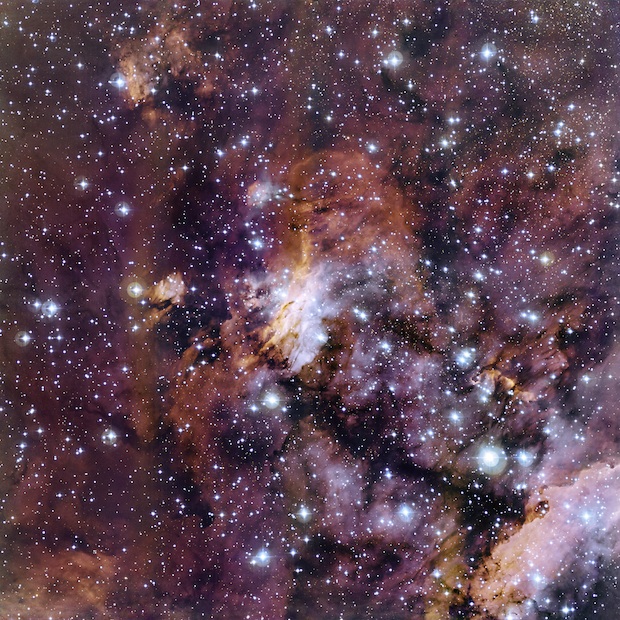The Prawn Nebula, a place where stars are born
Ever wonder what a nursery for stars looks like?
If this image is any indication, it's a beautiful but chaotic place. Taken with the MPG/ESO 2.2-metre telescope at the La Silla Observatory in Chile, as part of the European Southern Observatory's (ESO) Cosmic Gems program, the image is dominated by a gigantic nebula known as Gum 56 - nicknamed the Prawn Nebula. It is illuminated by three patches of hot, young stars that glow brightly in ultraviolet light.
It is the light from these stars that causes the nebula's gas clouds to glow.
"One of the things you have to take away from this is that it looks quite chaotic and really it is quite chaotic," Jeremy R. Walsh, a research astronomer with ESO, told CBS News. "There are stars forming in all different places. There is dust. There are clouds of gas and its all moving around. It's a complex scene."
There are also several light and dark patches throughout the image, Walsh said. The bright patches are the glowing gases and the dark patches or dense clouds are the stellar dust, he said. And since the dust absorbs the light, there are likely scores of young stars hidden behind those clouds.
The material forming these new stars includes the remains of the most massive stars from an older generation that have already ended their lives and ejected their material in violent supernova explosions.
"We are looking at a star forming region about 6,000 light years away," Walsh told CBS News. "In this region, the oldest star will be a few million years old and, in a region like this where you still lots of these dark patches with dust, they usually hide much younger stars that are still forming and may be less than 100,000 years old."
The stunning colors - mostly reds and blues - indicate the presence of hydrogen gas and ionized oxygen.
Gum 56, also known as IC 4628, is named after the Australian astronomer Colin Stanley Gum, who, in 1955, published a catalogue of H II regions. H II regions such as Gum 56 are huge, low density clouds containing a large amount of ionized hydrogen.
Gum 56 has a diameter of around 250 light-years. Despite its huge size, this nebula has often been overlooked by visual observers due to its faintness, and because most of the light it emits is at wavelengths not visible to the human eye.
A large portion of the ionization in Gum 56 is done by two O-type stars, which are hot blue-white stars, also known as blue giants because of their color. This type of star is rare in the universe, as the very large mass of blue giants means that they do not live for long. After only roughly a million years, these stars will collapse in on themselves and end their lives as supernovae, as will many of the other massive stars within the nebula.
This image harkens back to a much more famous nebula photograph, "The Pillars of Creation." That image was taken by the Hubble Telescope and rephotographed as part of its 25th birthday.
"Although you may say that looks different, to me actually that looks rather similar," Walsh said. "Again, it's these pillars of dust against the background nebula. That is the kind of thing we see in this image. It's just this nebula turned out to be a little further away. It's not quite so spectacular."
